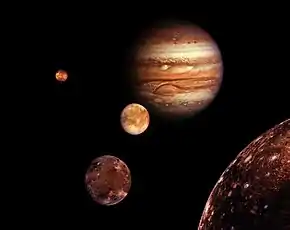Neso (moon)
Neso /ˈniːsoʊ/, also known as Neptune XIII, is the outermost known natural satellite of Neptune. It is an irregular moon discovered by Matthew J. Holman, Brett J. Gladman, et al. on August 14, 2002, though it went unnoticed until 2003.[2][5] Neso orbits Neptune at a distance of more than 48 Gm (million km), making it (as of 2015) the most distant known moon of any planet. At apocenter, the satellite is more than 72 Gm from Neptune. This distance is great enough to exceed Mercury's aphelion, which is approximately 70 Gm from the Sun.

 Neso imaged by the Very Large Telescope's FORS1 imager in September 2002 | |
| Discovery[1][2] | |
|---|---|
| Discovered by |
|
| Discovery date | August 14, 2002 |
| Designations | |
Designation | Neptune XIII |
| Pronunciation | /ˈniːsoʊ/ |
Named after | Νησώ Nēsō |
| S/2002 N 4 | |
| Adjectives | Nesoan /nɪˈsoʊ.ən/ or Nesoian /nɪˈsoʊ.iən/ |
| Orbital characteristics[3] | |
| Epoch June 10, 2003 | |
| Periapsis | ~21,215,700 km (0.141 AU) |
| Apoapsis | ~77,784,500 km (0.518 AU) |
| 0.33 AU (~49,500,000 km), 3,220 Neptune radii, 49.285 | |
| Eccentricity | 0.5714 |
| 9740.73 d (26.67 y) | |
| Inclination | 136.439 |
| Physical characteristics | |
Mean diameter | 60 km[4] |
| Albedo | 0.04 (assumed)[4] |
Neso is also the moon with the longest orbital period, 26.67 years. It follows a retrograde, highly inclined, and highly eccentric orbit illustrated on the diagram in relation to other irregular satellites of Neptune. The satellites above the horizontal axis are prograde, the satellites beneath it are retrograde. The yellow segments extend from the pericentre to the apocentre, showing the eccentricity.
Neso is about 60 km (37 mi) in diameter based on an assumed albedo, and assuming a mean density of 1.5 g/cm3,[6] its mass is estimated at 2×1017 kg.
Given the similarity of the orbit's parameters with Psamathe (S/2003 N 1), it was suggested that both irregular satellites could have a common origin in the break-up of a larger moon.[4]
Neso is named after one of the Nereids. Before the announcement of its name on February 3, 2007 (IAUC 8802), Neso was known by its provisional designation, S/2002 N 4.
References
- JPL (2011-07-21). "Planetary Satellite Discovery Circumstances". Jet Propulsion Laboratory. Retrieved 2011-10-24.
- Green, Daniel W. E. (October 1, 2003). "S/2001 U 2 and S/2002 N 4". IAU Circular. 8213. Retrieved 2011-10-24.
- Jacobson, R. A. (2008). "NEP078 – JPL satellite ephemeris". Planetary Satellite Mean Orbital Parameters. Retrieved 2009-09-23.
- Sheppard, Scott S.; Jewitt, David C.; Kleyna, Jan (2006). "A Survey for "Normal" Irregular Satellites around Neptune: Limits to Completeness". The Astronomical Journal. 132: 171–176. arXiv:astro-ph/0604552. Bibcode:2006AJ....132..171S. doi:10.1086/504799.
- Holman, M. J.; Kavelaars, J. J.; Grav, T.; et al. (2004). "Discovery of five irregular moons of Neptune" (PDF). Nature. 430 (7002): 865–867. Bibcode:2004Natur.430..865H. doi:10.1038/nature02832. PMID 15318214. Retrieved 24 October 2011.
- Physical parameters from JPL
- MPC: Natural Satellites Ephemeris Service
- Mean orbital parameters from JPL


_flatten_crop.jpg.webp)